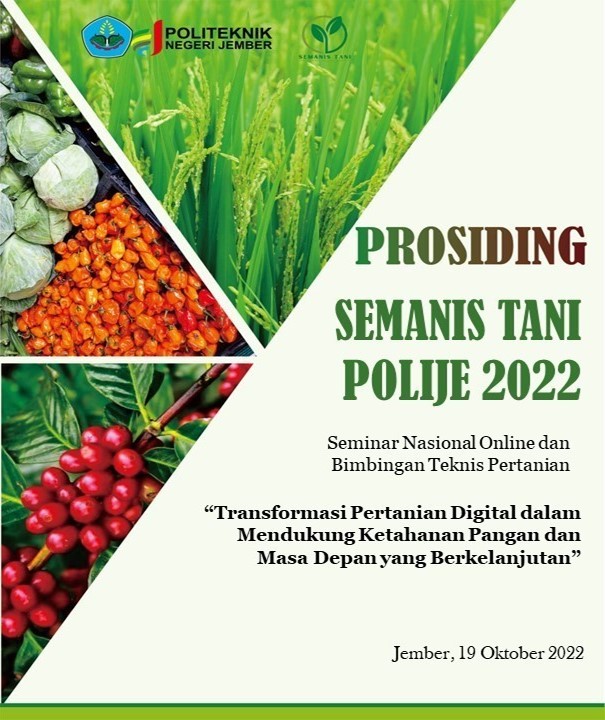Identifikasi Bioprospeksi Senyawa Aktif Terkandung Dalam Bahan Baku Sirup Herbal Kube Minuman Herbal Resort wonosari Taman Nasional Meru Betiri
DOI:
https://doi.org/10.25047/agropross.2022.323Kata Kunci:
Active Compounds, Biosrospecting, Herbal DrinksAbstrak
Herbal drinks are one of the alternatives to traditional medicine that are in demand by people in Indonesia. The research program of the ICCTF (Indonesian Climate Change Trust Fund) and the University of Jember in 2017-2018 produced one of the outputs in the form of the formation of the Herbal Drinks KUBE in Wonoasri Village, Tempurejo District, Jember Regency. However, these herbal products do not yet have detailed composition of the active components so they cannot be registered with the Health Office. One of the products produced by KUBE is Herbal Syrup which is made from various kinds of spices originating from the protected forest area of Meru Betiri National Park. The efficacy produced by herbal drinks is thought to come from the active compounds contained in spices as raw materials for beverages. To determine the potential content of these herbal drinks, it is important to carry out a bioprospection analysis of the raw materials of herbal drinks from Meru Betiri National Park in an effort to determine the active compounds contained. This research was preceded by conducting interviews with herbal medicine craftsmen KUBE Herbal drink in Wonoasri village to find out the composition or raw materials used in making Herbal Syrup. Furthermore, the collection of raw materials from TNMB for extraction by the maceration method and qualitative analysis was carried out on the active compounds contained. The results obtained that the plant raw materials for herbal syrups namely Ginger, Javanese Chili, Lemongrass and Turmeric positively contain Alkaloids, Flavonoids, Phenols, Tannins, Saponins, Essential Oils. All samples also showed that they did not contain steroid compounds, and Jabe Jawa did not contain tannins.
Unduhan
Referensi
Achmad, S.A. 1986. Kimia Organik Bahan Alam. Jakarta: Karnunika.
Allo, Maranty B.R.2016. Uji Aktivitas Antibakteri Dari Esktrak Air Kulit Buah Pisang Ambon Lumut(Musa acuminata Colla) Terhadap Pertumbuhan Staphylococcus aureus.Skripsi.Universitas Sanata Dharma:Yogyakarta
Chiang C.E.W., Ying E.S., Tan Y.P., Wong Z.C., Lye P.Y., and Tan L.N. 2012. Antioxidant and Sensory Properties of Thai Herbal Teas with Emphasis on Thunbergia laurifolia Lindl. Chiang Mai J. Sci.: 39(4): 599-609.
Depkes RI. 2008. Farmakope Herbal Indonesia.Edisi 1. Jakarta: Departemen Kesehatan Republik Indonesia.
Ergina, S.N., dan Indarini D.P.2014. Qualitative Test of Secondary Metabolites Compounds in Palado Leaves (Agave Angustifolia) Extracted With Water and Ethanol. J. Akad. Kim. 3(3): 165-172.
Guenther, E. 2011. Minyak Atsiri. Jakarta : UI Press.
Harbone, J.B. 1987. Metode Fitokimia Penentuan Cara Modern Menganalisis Tumbuhan. Penerjemah Kosasih Padmawinata dan Iwang Soediro. Bandung: Institut Teknologi Bogor.
Harborne, J.B., 1984. Phitochemical Method. London: Chapman and Hall ltd. Ikan, R. 1969. Natural Product A Laboratory Guide. Jerussalem: Israel Universities Press. Illing, Ilmiati., Wulan S., dan Erfiana. 2017. UJi Fitokimia Ekstrak Buah Dengen. Jurnal Dinamika Vol. 08. No.1.
Kristanti, A.N., Aminah, N.S., Tanjung, M., dan Kurniai, B. 2008. Buku Ajar Fitokimia. Surabaya: Universitas Airlangga.
Mainawati, Dw., Eti M.B., dan Jismi M. 2017. Uji KAndungan Metabolit Sekunder Tumbuhan Obat Yang Terdapat Di Kecamatan Rambah Samo Kabupaten Rokan Hulu. Jurnal Mahasiswa Prodi Biologi UPP.
Mastuti, Retno.2016. Modul 3 Fisiologi Tumbuhan Metabolit Sekunder dan Pertahanan Tumbuhan. Jurusan Biologi FMIPA Universitas Brawijaya.
Minarno, E.B. 2015. Skrining Fitokima Dan Kandungan Total Flavonoid Pada Buah Carica pubescens Lenne & K. Koch Di Kawasan Bromo, Cangar, Dan Dataran Tinggi Dieng. Jurnal El-Hayah Vol. 5 No. 2.
Moelyono, M.W., 1996. Panduan Praktikum Analisis Fitokimia. Bandung: Laboratorium Farmakologi Jurusan Farmasi FMIPA. Universitas Padjadjaran.
Polski MR. The institutional economics of biodiversity, biological materials and bioprospecting. Ecological Economics. 53 : 543–557.
Pratama, D.G.A., Yuda I Gusti A.G.B., dan I Wayan G.G. 2016. Isolasi Dan Identifikasi Senyawa Minyak Atsiri Dari Tumbuhan Sembukan (Paederia foetida L.)Dengan Metode Kromatografi Gas-Spektroskopi Massa (GC-MS). Jurnal Kimia Vol 10 No 1.
Riyadi I. 2008. Potensi pengelolaan bioprospeksi terhadap pertumbuhan ekonomi Indonesia. Jurnal Litbang Pertanian. 27(2) : 69-73.
Siah W.M., Azman M.A., Jeeven K., Noor H.M.D., and Mohd T.S. 2011. Effect of Infusion Conditions on Total Phenolic Content and Antioxidant Activity in Centella asiaticaTea. J. Trop. Agric. and Fd. Sc. 39(2):149–156.
Suryanto, E. dan F. Wehantouw. 2009. Aktivitas Penangkapan Radikal Bebas dari Ekstrak Fenolik Daun Sukun (Artocarpus altilis F.). Chem. Prog., 2 (1): 1-7.
Susanto A. 2013. Meningkat, Tren Pengobatan Herbal di Indonesia. http://health.liputan6.com/read/627062/meningkat-tren-pengobatan-herbal-di indonesia. Tanggal akses: 02/04/2019
Thompson, E. B. 1985. Drug Bioscreening. America: Graceway Publishing Company, Inc. Pp. 40, 118.
Ullah, Shakir., Gul J., Farzana G., Siraj K., and Jan S. 2018. Antifungal, nutritional and phytochemical investigation of Asplenium dalhousiae of district Dir Lower, Pakistan. Journal of Pharmacognosy andPhytochemistry 7(2): 3281-3288.
Vogel. 1978. Text Book Of Practical Organic Chemistry, 4th Edition. London: Longman Group Limited.
Unduhan
Diterbitkan
Cara Mengutip
Terbitan
Bagian
Lisensi
Hak Cipta (c) 2022 Tri Ratnasari, Hari Sulistiyowati, Dwi Setyati

Artikel ini berlisensi Creative Commons Attribution 4.0 International License.
Hak cipta (Copyright) artikel yang dipublikasikan di Agropross : National Conference Proceedings of Agriculture dipegang oleh penulis (Copyright by Authors) di bawah Creative Commons Attribution 4.0 International License (CC-BY). Sehingga penulis tidak memerlukan perjanjian pengalihan hak cipta yang harus diserahkan kepada redaksi.






